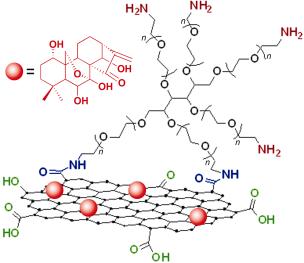

Chinese Journal of Organic Chemistry >
Functionalized Graphene Oxide as a Nanocarrier for Loading and Delivering of Oridonin
Received date: 2012-11-16
Revised date: 2012-12-01
Online published: 2012-12-07
Supported by
Project supported by the National Natural Science Foundation of China (Nos. 31100549, 21204098), the Shanghai Rising Star Program (No. 11QH1402800), and the Shanghai Scientific and Technological Innovation Project (No. 10431903000).
Graphene oxide (GO) was prepared by modified Hummers method firstly. In order to improve its water solubility and biocompatibility, 6-armed PEG was grafted onto GO via an amidation process. The size of GO-PEG was less than 250 nm and stability test indicated excellent dispersibility of GO-PEG in water and PBS buffer. Furthermore, oridonin, a widely used cancer chemotherapy drug, is adsorbed onto GO-PEG via blending. The drug loading ratio was determined to be as high as 105%, which was much higher than other common drug carriers. A549 lung cancer cell and MCF-7 breast cancer cell were chosen to study the cytotoxicity of GO-PEG/oridonin, GO-PEG, and free oridonin. The results demonstrated that GO-PEG did not show obvious toxicity (relative cell viability>85%), even cultivated for 48 h at a relatively high concentration of 100 mg/L. Compared to oridonin, the GO-PEG/oridonin nanocarrier shows higher cytotoxicity in A549 and MCF-7 cells.

Key words: graphene oxide; oridonin; drug delivery
Xu Zhiyuan , Li Yongjun , Shi Ping , Wang Bochan , Huang Xiaoyu . Functionalized Graphene Oxide as a Nanocarrier for Loading and Delivering of Oridonin[J]. Chinese Journal of Organic Chemistry, 2013 , 33(03) : 573 -580 . DOI: 10.6023/cjoc201211033
/
| 〈 |
|
〉 |